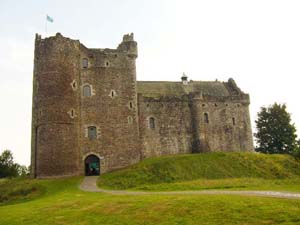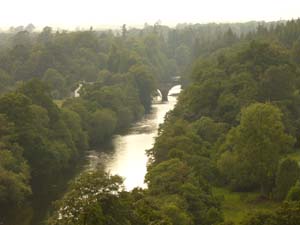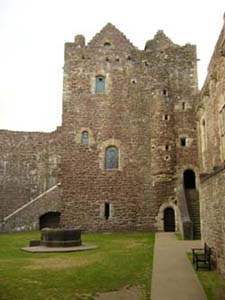
Doune
8 miles North west of Stirling, on A84
Tel 01786 841742

Guarding one of the main routes between Stirling and the Highlands, Doune castle played an important role in governing Scotland.
Doune Castle was built largely in the 14th century by Robert Stewart, Duke of Albany. He virtually ruled Scotland during the reign of Robert III between 1388 and 1420.
Robert Stewart died in 1320 and his son Murdoch inherited the role of Regent of Scotland. Murdoch was imprisoned , then beheaded when James I returned from captivity in England. James I believed his family had done too little to secure his release. Doune Castle was confiscated by the Crown and was used as a royal hunting lodge.

The best preserved medieval castle in Scotland lies South of where the River Teith and the Ardoch Burn meet.
The splendour of Doune Castle has been re imagined following months of consultation with archaeologists and historians. A colourful and dramatic illustration reconstructing life at the Castle is now installed at Doune. Specialists within and outside the agency contributed their expertise to the project, producing a lively resource that brings new insight into life at the Castle.
The new interpretation shows a cut away view of the Castle, with views into the richly furnished interior of the gatehouse tower, the Great Hall, the Duke's hall which has an unusual double fireplace reflecting Albany's importance, upper rooms including an oratory for private prayer, the kitchen, and postern gate.
Offering a surprising amount of detail, artist David Simon has created a stunning illustration showing the Duke of Albany entertaining guests at Doune Castle in February 1407. Albany was the most powerful man in Scotland at the time, and ruled the kingdom on behalf of three successive kings. Doune was the Duke's power base, a magnificent noble residence, designed to show off his wealth and prestige.
The Stewarts used the castle as a country retreat from Stirling. The castle was occasionally used by Mary Queen of Scots and was held by men loyal to her until 1570.
The castle was used as a prison for government supporters during the 1745 Rebellion. John Hume, the author and some other prisoners escaped by knotting together bedsheets and climbing from the kitchen window.

The castle is protected by two rivers, surrounding banks and dry ditches.
There is a 95 foot gatehouse, vaulted rooms, a splendid Lord's Hall with it's carved oak screen, musicians gallery and double fireplace.
The castle fell into ruin but was restored by the 14th Earl of Moray in 1883 and is currently maintained by Historic Scotland.
Doune Castle is in demand as a film location and can be seen in Ivanhoe and Monty Python and the Holy Grail. The Monty Python and The Holy Grail song and dance routine at Camelot was filmed in the Great Hall at Doune Castle and the servery and kitchen appear as Castle Anthrax, where Sir Galahad the Chaste Michael Palin is chased by seductive women. The wedding disrupted by Sir Lancelot John Cleese was filmed in the courtyard and Great Hall.
Doune Castle has featured in several literary works, including the 17th century ballad The Bonny Earl of Murray which relates the murder of James Stewart, 2nd Earl of Moray by the Earl of Huntly in 1592. In Sir Walter Scott's first novel, Waverley, 1814, the protagonist Edward Waverley is brought to Doune Castle by the Jacobites. Scott's romantic novel describes the 'gloomy yet picturesque structure', with its 'half ruined turrets'.
The castle was used as a location in MGM's 1952 historical film Ivanhoe, starring Robert Taylor and Elizabeth Taylor, and for the HBO TV series Game of Thrones.
Photographs © Alice Gent
Open
All year
1 April to 30 September
Monday to Sunday 9.30am to 6.30pm
Winter
October
Monday to Sunday 9.30am to 4.30pm
November to March
Saturday to Wednesday 9.30am to 4.30pm
Closed Thursdays
Last tickets sold at 6pm or 4pm in winter
Christmas and New Year Period
Closed 25th, 26th December and 1st, 2nd January.